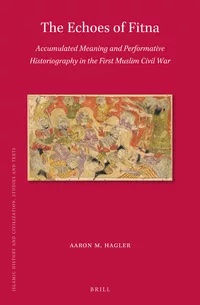Hagler (Aaron M.), The Echoes of Fitna Accumulated Meaning and Performative Historiography in the First Muslim Civil War, Leiden, Brill, ("Islamic History and Civilization ; 197") 2023, 176 p. ISBN 978-90-04-52425-5
Auteur
Aaron M. Hagler, Ph.D. (2011), University of Pennsylvania, is Associate Professor of History at Troy University. He has previously published work in the International Journal of Middle East Studies, Arabica, and Der Islam, among others.
Presentation

In The Echoes of Fitna, Aaron M. Hagler engages in a close reading of the fitna narratives of three related texts : al-Ṭabarī’s Taʾrīkh al-rusul wa-l-muluk, Ibn al-Athīr’s al-Kāmil fī al-taʾrīkh, and Ibn Kathīr’s Kitāb al-bidāya wa-l-nihāya. Because the latter two texts’ presentations of the fitna follow al-Ṭabarī’s so closely, moments of divergence in the texts are understood as clear markers of the later historians’ goals, perspectives, and literary-narrative strategies.
The analysis of these changes demonstrates that the desire to reframe the meaning of Karbalāʾ is central to Ibn al-Athīr’s and Ibn Kathīr’s narrative construction, and that—while they left al-Ṭabarī’s versions of key events intact—small, even minute changes to contextual expository moments fundamentally change their meaning.
Table des matières
Acknowledgements
Introduction : Making Use of Uncertainty
1 The Later Historians : Ibn al-Athīr and Ibn Kathīr
2 Their Source
3 Establishing the Texts’ Relationships
4 Methodology : Performative Historiographical Analysis
5 Mapping the Fitna
6 Structure
1 Historical Background of the Fitna and Its Histories
1 A Brief History of Islam before Our Extant Sources and the Emergence of Sectarian Rivalry
2 The Raw Data : The Sectarian Narratives
3 The Fitna as Narrative
4 Historical Context : Damascus during and after the “Sunnī Revival”
5 Conclusion
Part 1 The Slaughter at Karbalāʾ
2 The Karbalāʾ Narrative
1 The Story of Karbalāʾ
2 Ibn Kathīr on al-Ḥusayn ibn ʿAlī
3 Ibn al-Athīr on Karbalāʾ
4 Conclusion
3 The Fight and Its Aftermath
1 The Immediate Preparation
2 The Battle
3 Conclusion
4 Approaching Karbalāʾ
1 Towards Karbalāʾ
2 Umayyad Representatives, Softened and Erased
3 Al-Ḥusayn is Detained and Denied Water
4 Conclusion
5 Next Stop
Part 2 The Betrayal at Ṣiffīn
5 The Ṣiffīn Narrative
1 Sourcing Ṣiffīn
2 The Elements of the Story
3 The Stakes
6 The Battle of Ṣiffīn : Fight and Conclusion
1 Introduction
2 A Broken Link to the Prophet : The Battlefield Death of the Elderly ʿAmmār ibn Yāsir
3 Arbitration, Negotiation, and a Portentous Stalemate
7 Preparing the Battle
1 Introduction
2 The Battle of the Camel
3 The Allegiances of ʿAmr ibn al-ʿĀṣ and Abū Mūsā al-Ashʿarī
4 The Correspondence between ʿAlī and Muʿāwiya
5 The Battle by the Water : Softening Umayyad Villainy at Ṣiffīn
6 Conclusion
Part 3 The Election of ʿUthmān
8 The Story of ʿUthmān
1 The Shūrā
2 Six Good Years, Six Bad Years
3 Muʿāwiya on the Minbar
4 The Stakes
5 Six Good Years and Six Bad Years : The Caliphate of ʿUthmān ibn ʿAffān
9 The Shūrā of ʿUthmān
1 Introduction
2 Narrating the Shūrā
3 ʿAbd al-Raḥmān ibn ʿAwf : Cynical or Sincere ?
4 ʿAlī’s Reactions : Playing the Wild Card
5 Looking Backward
Part 4 Further Ripples
10 The Stories of Succession
1 Introduction
2 The Death of the Prophet and the Sāqifa
3 The Caliphate of ʿUmar ibn al-Khaṭṭāb
4 The Stakes
11 The Prophet Muḥammad and His Role in the Narrative
Conclusion : The Tapestry of History
1 Karbalāʾ the Pebble
Bibliography
Index
